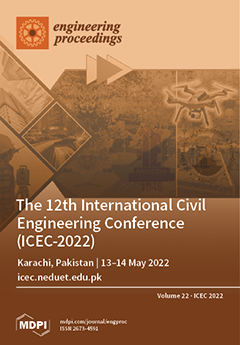Eng. Proc., 2022, ICEC 2022
The 12th International Civil Engineering Conference (ICEC-2022)
Karachi, Pakistan | 13–14 May 2022
Volume Editors:
Sarosh H. Lodi, NED University of Engineering & Technology, Karachi, Pakistan
Sohail Bashir, NED University of Engineering & Technology, Karachi, Pakistan
Abdul Jabbar Sangi, NED University of Engineering & Technology, Karachi, Pakistan
Shamsoon Fareed, NED University of Engineering & Technology, Karachi, Pakistan
- Issues are regarded as officially published after their release is announced to the table of contents alert mailing list.
- You may sign up for e-mail alerts to receive table of contents of newly released issues.
- PDF is the official format for papers published in both, html and pdf forms. To view the papers in pdf format, click on the "PDF Full-text" link, and use the free Adobe Reader to open them.




